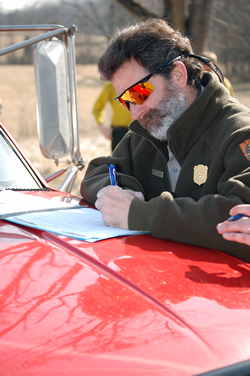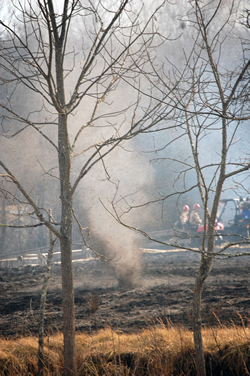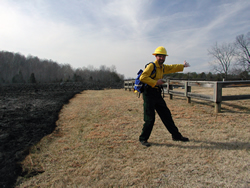
National Fire Plan Success Story
Smoke of a Different Kind
Appomattox Court House National Historical Park, Virginia
National Fire Plan - Fuels Reduction
2009

Conditions are within prescription and Superintendent Reed Johnson authorizes the February 9th burn. NPS photo by Barb Stewart.

Late in the day, the fire generated a brief fire whirl that became a dust devil before spinning itself out. NPS photo by Barb Stewart.

Brian Eick, Chief of Natural Resources at the park, shows that the burn went according to plan and did not impact the nearby cemetery. NPS photo by Barb Stewart.
It was not the smoke of soldiers’ campfires. On February 9, 2009, the smoke rising from Ferguson Field came from the park’s first prescribed burn. The predominantly grassy 25-acres at Appomattox Court House National Historical Park burned according to plans. Why go to all the work? Prescribed fire is part of the field management program, restoring and maintaining native grasses and the historic cultural landscape.
Ferguson Field was one of the places soldiers camped awaiting the work of generals. On April 9, 1865, Commanding General of the Army of Northern Virginia Robert E. Lee surrendered his men to General-in-Chief of all United States Forces Ulysses S. Grant. Though several Confederate armies under different commanders remained in the field, Lee’s surrender signaled the end of the Southern States’ attempt to create a separate nation.
As always, safety was the first priority. No one was injured, everyone learned something, and one trainee made progress on his task book. There were no smoke issues or closures. Smoke warning signs had been posted on nearby roadways, but smoke rose and dispersed quickly. A Lynchburg, Virginia, newspaper sent a reporter and photographer to observe the work. Their stories, in words and pictures, made the front page and the paper’s website.
Vegetation was certainly affected by the planned burn, primarily thatches of cool season grasses, cedar trees, and a few small pines. As desired, the fire appeared to create better opportunities for native grasses. Monitoring will continue in the months to come to see just how beneficial this first burn was for the park.
Contact: Barb Stewart, Fire Communication Specialist, Northeast & National Capital Regions, (434) 220-9065.